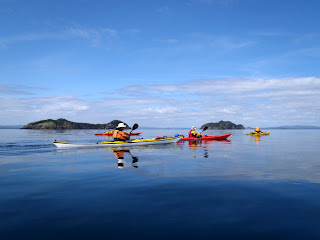The track back
Thursday's track back to civilization and the conclusion of a great trip.
Almost round
Some thirty minutes after leaving St. Bernard's Cove, Dean and I arrived at the northern tip of Merasheen Island.
Grabbing hold
Dean grabs a hold of Merasheen and our circumnavigation is complete. It was hard to believe six days had passed since we were last in the same spot.
The others arrive
The rest of the crew arrives. We linger for some time to enjoy the moment, the feeling of accomplishment before we cross the central channel to Long Island and then on to Arnolds Cove.
Oily calm seas
On a bright, clear and calm day we crossed in front of Bread and Cheese Islands on our way to Arnolds Cove.
A long way off
Arnolds Cove still lay a long way off in the distance but we could see where we were headed. Last year on the same crossing, we did it in fog having to rely on the compass.
Land ho!
At the entrance to Arnolds Cove I stopped to take a picture of Dean. We had a look back to where we had come from before paddling the last few strokes onto the beach.
Arrival
Clyde, Dean and I were on the beach as Hazen and Neville paddle in. Behind them, on the far distant horizon, barely seen lay Long and Merasheen Islands.
It was an epic trip, at least it was for us. It seems like every trip I do is an epic trip until I do the next one. This one was special though. Not a lot of people paddle to Merasheen so it is very much the road less traveled.
Fish and chips
With all the gear packed into the vehicles we drove the short distance to Megan's Restaurant where we had a great meal of fish and chips. I had a three piece. I felt I deserved it.
Here's a picture of the happy gang. Clockwise from left: Dean, myself, Clyde, Neville and Hazen. Thanks guys for an excellent trip, one I will always look back on withfond memories.

























































